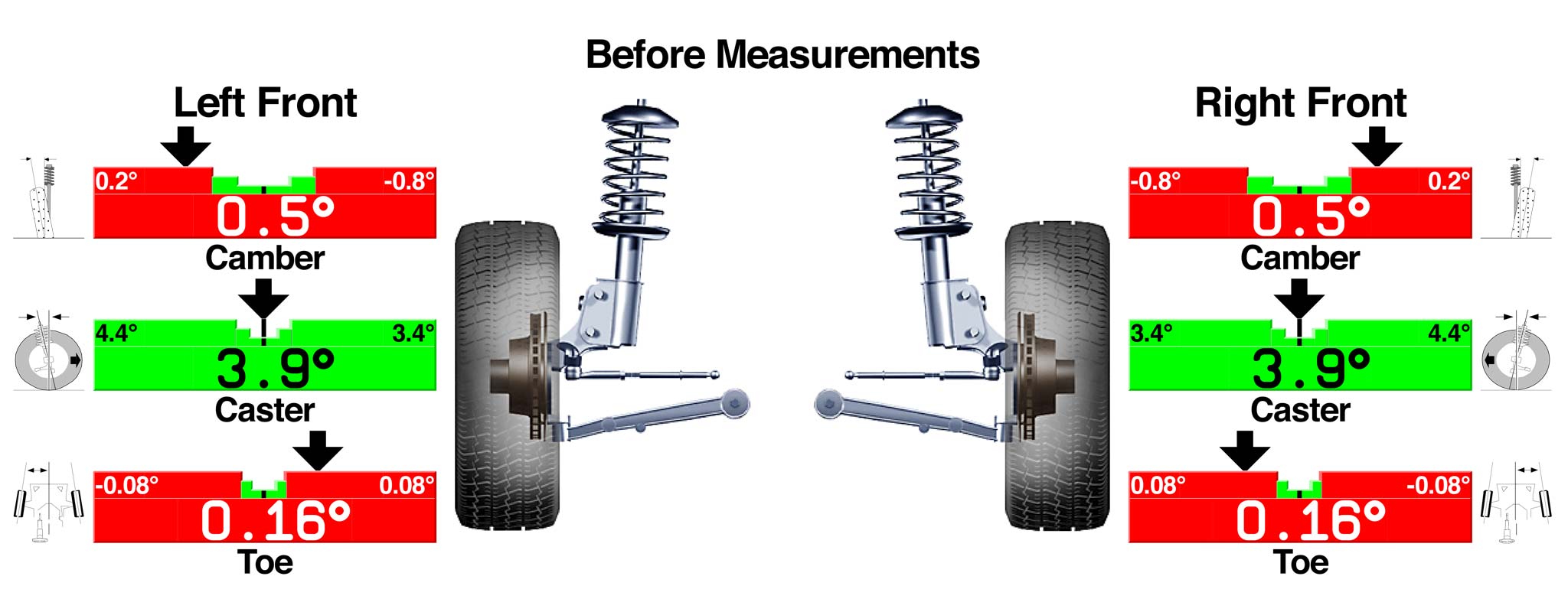Do I Really Need an Alignment for My Vehicle?
You don’t have to go off-roading or hit hundreds of potholes and speed bumps to cause alignment issues. Everyday driving can put your wheels out of alignment. Over time, those misaligned tire and wheel assemblies will impact your gas mileage (MPG), cause tires to wear out faster, and reduce drivability. Here’s why you need regular wheel alignments and how Les Schwab can help.
What Is a Wheel Alignment?
A wheel alignment is the process of adjusting the angles of your vehicle’s steering and suspension components back to original specifications. This means the front and rear wheels are in alignment with the vehicle’s centerline — optimizing driveability and fuel efficiency. An alignment is done using a special machine that measures the wheel angles against your vehicle’s original specs. The technician then makes adjustments as needed.
When your vehicle needs to be realigned, the experts at Les Schwab will do an alignment that is most appropriate for your vehicle. These may include 4-wheel alignment for front-wheel drive, all-wheel drive, and most passenger vehicles, and thrust alignment for many larger trucks and SUVs.
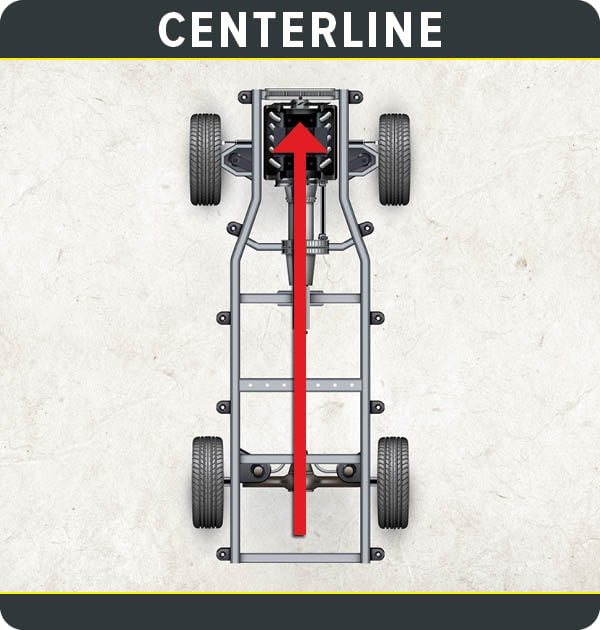
Why Your Alignment Is Important
Regular alignments should be done twice a year as part of your basic auto maintenance. Why? Because misaligned tire and wheel assemblies will impact your gas mileage, cause tires to wear out faster, and reduce drivability.
When your vehicle is in alignment, all four wheels will be pointed the same direction and lined up from front to rear and contacting the road at the proper angle.
How Your Vehicle Gets Out of Alignment
Dirt roads, bumpy highways, potholes, as well as hitting curbs and speed bumps can throw your vehicle out of alignment. Additionally, alignment issues will happen slowly over time due to normal wear and tear.
To quickly analyze your car’s alignment, ask yourself these questions during your next drive:
- Does your car or truck pull to one side when driving?
- Is your steering wheel turned slightly to one side when driving straight?
- When you come out of a turn, does your steering wheel return to center easily? In other words, does it go back to center (or nearly center) without a lot of work from you.
- Are you constantly making small steering corrections on the highway or freeway?
- Do you have excessive wear on the inside or outside of one or more of your tires?
Answering yes to any of the above could mean your car or truck needs an alignment. However, because alignment issues can be tough to spot, it’s a good idea to have yours checked twice per year even if you don’t notice any issues.
Les Schwab Tip: It’s a common misconception that you only need an alignment when the vehicle is handling improperly. This is often not the case. Getting your alignment checked twice per year can prevent unexpected tire wear and/or fuel economy.
Common Wheel Misalignment Signs & Symptoms
It’s important to maintain proper wheel alignment on your vehicle. While getting your alignment done once or twice a year is advisable, there are other times when an alignment may be necessary to avoid loss of gas mileage and excessive tire wear.
This can include any of the following:
You Get New Tires:
We recommend an alignment after the installation of new tires. This helps you get the most life from your new tires. Wheel alignment checks are always advised after a significant impact or uneven tire wear is detected.
You Lower or Lift Your Vehicle:
Lifting or lowering a vehicle will affect your toe, camber or caster angles. So will repair or replacement of suspension and steering parts — struts, shocks, ball joints, tie rods, bushings or control arms. If one of these components is damaged, it’s a pretty good bet your vehicle’s alignment is out of spec.
Adjustments or Replacement of Suspension Parts:
This can affect the angle of your tires and wheels.
You’ve Had a Fender-bender or a Hard Impact With a Curb or Road Debris:
This can include potholes and other hazards. Stop by Les Schwab and we’ll do a free visual inspection.
It’s Been a Year Since Your Last One:
An annual alignment can help save you money and add safety to your outings and everyday commute.
You Notice Uneven Tire Wear or Uneven Steering Wheel:
The most common signs of misalignment are pulling to one side while you’re driving, unusual tire wear and/or a steering wheel that’s off-center even though your vehicle is pointed straight. But these symptoms can have other causes, sometimes simpler and sometimes not.
An off-center steering wheel can be caused by worn steering or suspension parts. Just getting an alignment may not fix the root cause.
Irregular tire wear isn’t only limited to suspension parts, fender-benders, or alignment issues, but it’s a good place to start. Stop by Les Schwab for a free pre-trip safety check, which includes a visual inspection of alignment and related steering and suspension components that keep you safe on the road.
Les Schwab Tip: There’s no downside to an alignment check at Les Schwab. If we check your alignment and it doesn’t need any work, you won’t pay a thing.
Steering Pull Can Also Be Caused by Road Conditions
If the asphalt has grooves that are slightly farther apart than your car’s axles, you may feel a pull as the tires on one side ride slightly higher. If the road is noticeably higher in the center, the vehicle may veer as the tires try to find a level surface.
Les Schwab Tip: Vibration while underway is often a symptom of out-of-balance tires, not bad alignment.
What Is Your Technician Looking for During an Alignment Service
When you get your alignment done at Les Schwab, you’ll get our Best Alignment and Suspension Value Promise along with a job done right the first time. You’ll also get the full attention of one of our professional, certified technicians using best-in-class laser technology.
When they’re done, they’ll have your vehicle back in alignment, including the camber, caster, and toe.
Camber Affects Tire Wear
The inward and outward tilt of the tire and wheel assembly (viewed from the front of the vehicle) is called camber. When the top of the tire is leaning inward, it is a negative camber. Positive camber has the top of the tire tilting outward. Each manufacturer sets a specific camber alignment for every vehicle it produces, which might be either positive, negative or zero (0º). When the camber is at the correct angle, the tire and wheel will roll straight.
Generally, camber plays a key role in cornering performance. If the camber is out of the manufacturer’s range, it can cause handling issues and excessive tire wear, which costs you money. If a vehicle has rear-camber adjustments, adjusting the rear camber, in addition to the front, plays a big role in straight-line stability and cornering.
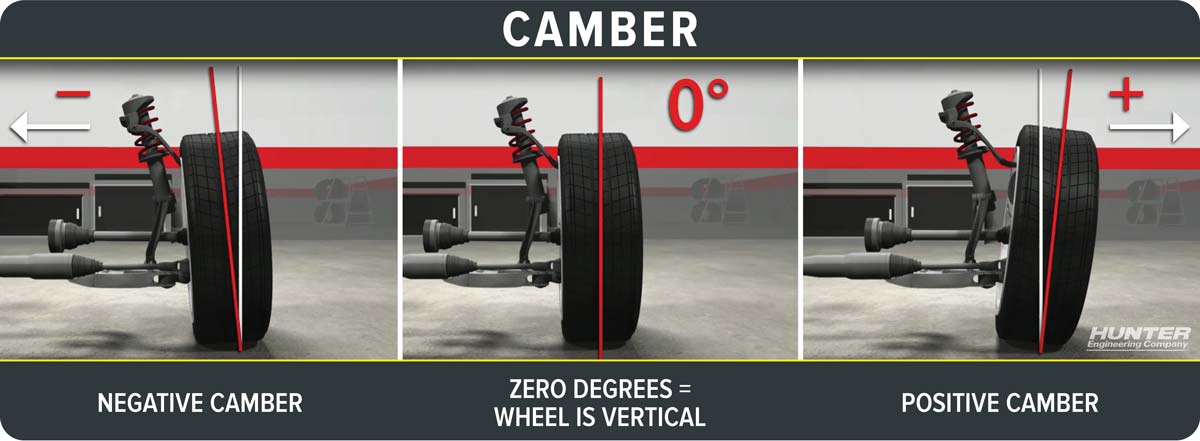
Image: Hunter Engineering Company
Caster Affects Steering and Handling
Ever tried to ride a bicycle without using your hands? The fact you could meant that your bicycle had a positive caster. If the caster had been zero (0º) or negative, riding that way would be nearly impossible. The same can be said for your vehicle.
Modern vehicles run a certain amount of positive caster with the steering axis tilted rearward toward the driver. While caster doesn’t affect tire wear like camber, it does have a big impact on steering and handling.
The higher the caster, the more stability a vehicle will have at higher speeds. Lower caster equals more responsive handling.
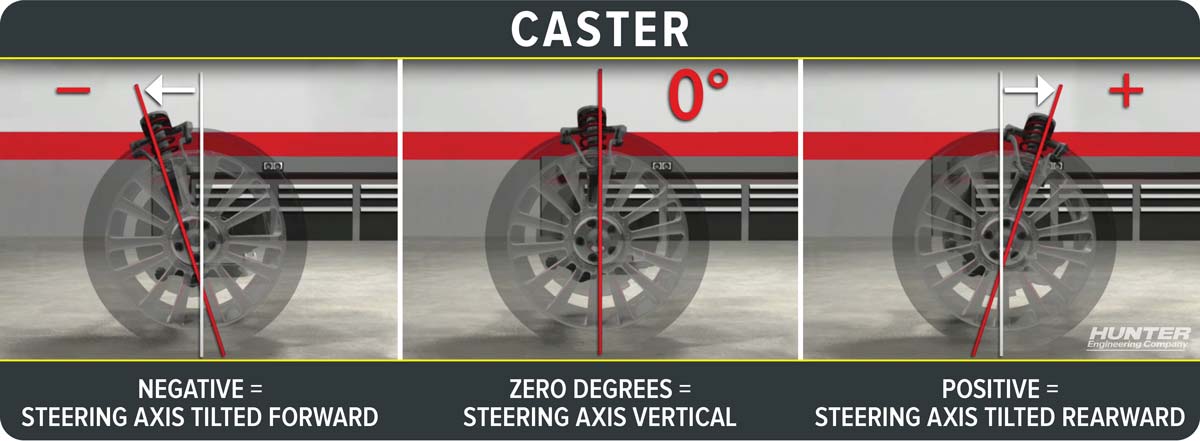
Image: Hunter Engineering Company
Toe Is the Most Important Angle for Tire Life
Of all the angles, the toe can fall out of alignment the easiest. A toe that is properly calibrated to manufacturer specifications (which can be either slightly positive or negative) will be at zero (0º) when on the road. This means all of the tire and wheel assemblies (front and rear) are pointing in the same direction.
What does it mean when the toe is out of alignment? It means your tires are wearing out faster than they should and you’re burning more fuel than is necessary. When the toe is at the correct angle, there’s less friction on the tires as they roll. When they are facing away from each other (toe-out) or toward each other (toe-in), they’re essentially scrubbing on the road ever so slightly with every passing mile.

Image: Hunter Engineering Company
Measurements Before and After an Alignment
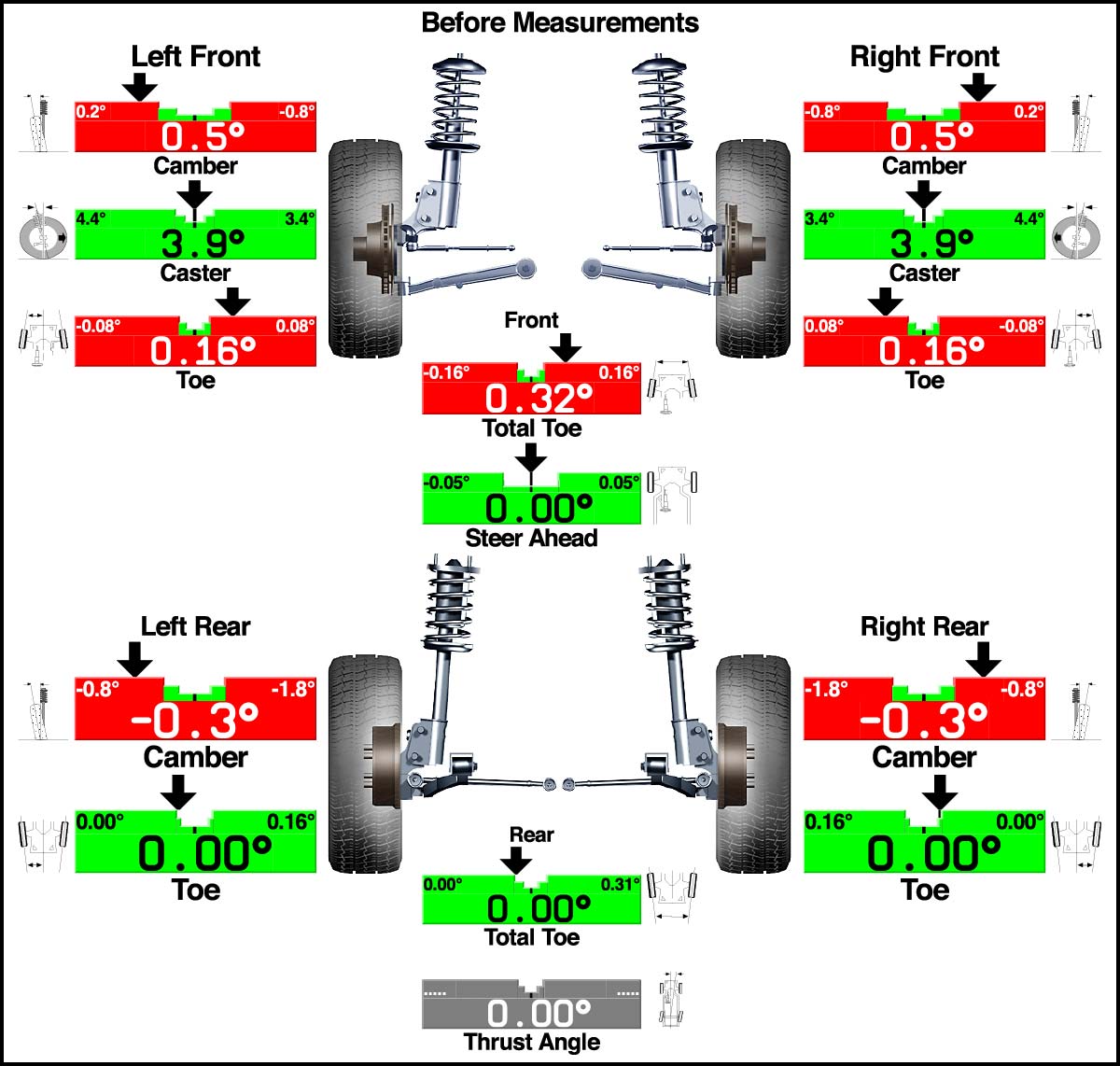
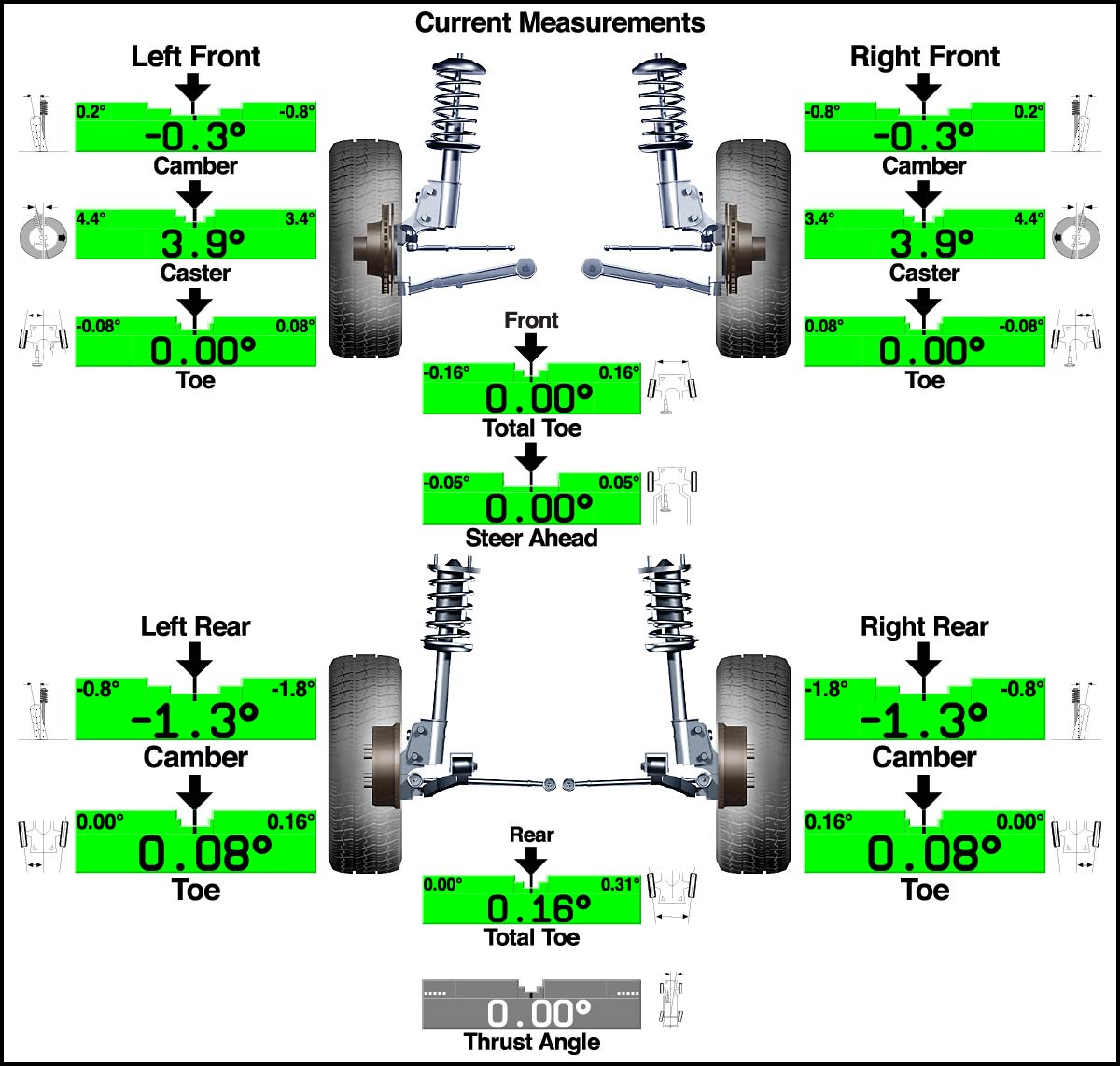
Tips Before Getting Service
Because the measurements are very fine, misalignment is not something you can see by just eyeballing whether the wheels and tire angles look right. But an experienced tire technician will usually know if you’re overdue for an alignment just by looking at your tire wear.
Here’s what to know if the service is recommended:
- If you have a damaged suspension part, replace it first. Worn or bad parts will put your vehicle right back out of spec.
- The technician may recommend a thrust alignment or a four-wheel alignment. Here’s a primer to understand what they’re talking about.
- Before service, let the tech know you’d like a printout showing what your alignment measurements were prior to the work being done and the final settings for your records.
We’ll Check Your Alignment for Free
Regular alignments are part of basic maintenance that help you get full mileage out of your tires. The pros at your local Les Schwab can take a look at your vehicle’s suspension and alignment components and let you know if you need any repairs. If everything is okay, it won’t cost you a thing. But if you do need an alignment, we’ll tell you what it will cost, give you a time estimate, and send you on your way with a Best Alignment and Suspension Value Promise, which includes a 30-day guarantee.
Schedule an Appointment

